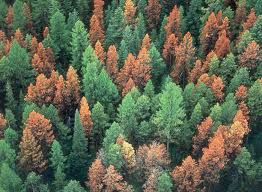
28 Sep EARTH MATTERS: INSECT OUTBREAKS IN COLORADO
As Telluride’s old-timers gather for a 40th anniversary celebration this weekend, my middle-aged mind drifted back to glory days of Colorado in the 1970s, when the Rocky Mountains were densely populated with healthy stands of aspen, pine, and spruce trees. Back to the days before armies of gypsy moths, mountain pine beetles, and spruce beetles decimated our scared forests.
This past summer while driving between Telluride and Denver, I was shocked to see hillside after hillside of trees, crippled by global warming-induced extreme insect outbreaks. Climbing up Loveland pass out of Silverthorne towards the crest of the Continental Divide, I took a visual survey of the surrounding landscape and discovered to my dismay that approximately 40% of the once vibrant forests were suffering a slow painful death.
In a healthy forest ecosystem, native insect disturbances can be part of the natural cycle of forest growth, mortality, fire, and regeneration. Typically, cold-blooded (poikilothermic) organisms such as mountain pine beetles, spruce beetles and gypsy moths have a two-year life cycle and their populations are normally controlled by months of cold wintertime temperatures. However, when a greater number of months have warmer average temperatures, they are able to complete a lifecycle in a single year. In addition, drought and heat stress also weakens a tree’s health, which can make it more vulnerable to insect attacks. According to the Aspen Global Change Institute, statistical modeling of spruce beetles predicts that the proportion of one-year life cycle beetles correlates to the number of cumulative hours above 62.9o F during the 40 to 90 days after peak adult emergence. Subsequently, climate change has the potential to increase the size and frequency of insect outbreaks and in turn the mortality of spruce and aspen trees.
Compounding the problem, high wind events down trees and create a habitat for insects to complete their lifecycle before flying to healthy standing trees that are more resistant to beetle infestation. In 1999, a wind event in the Baylor Park area affected 2,000 to 3,000 acres of spruce, fir, and aspen trees and fostered an insect epidemic. Making matters worse, dying trees add carbon to the atmosphere, which contributes to global warming. To date, the mountain pine beetle has damaged 1.5 million acres of Colorado’s forests.
Furthermore, the escalating trend of increasing summer temperatures has facilitated insect outbreaks at higher elevations, where summer temperatures have typically been too cold to allow single-year life cycles. Currently, a spectacular outbreak of mountain pine beetles has been occurring in the region of Vail. Extreme insect outbreaks at higher elevations could also threaten the long-term viability of these forests because they have not had enough time to co-evolve to the insect disruptions, as have forests at lower elevations. Thus, unless we take action to address human-induced global warming, aspen groves surrounding Telluride could eventually become vulnerable to gypsy moths that thrive at lower, warmer elevations.
The future of our beloved forests rests in our hands.




Sorry, the comment form is closed at this time.